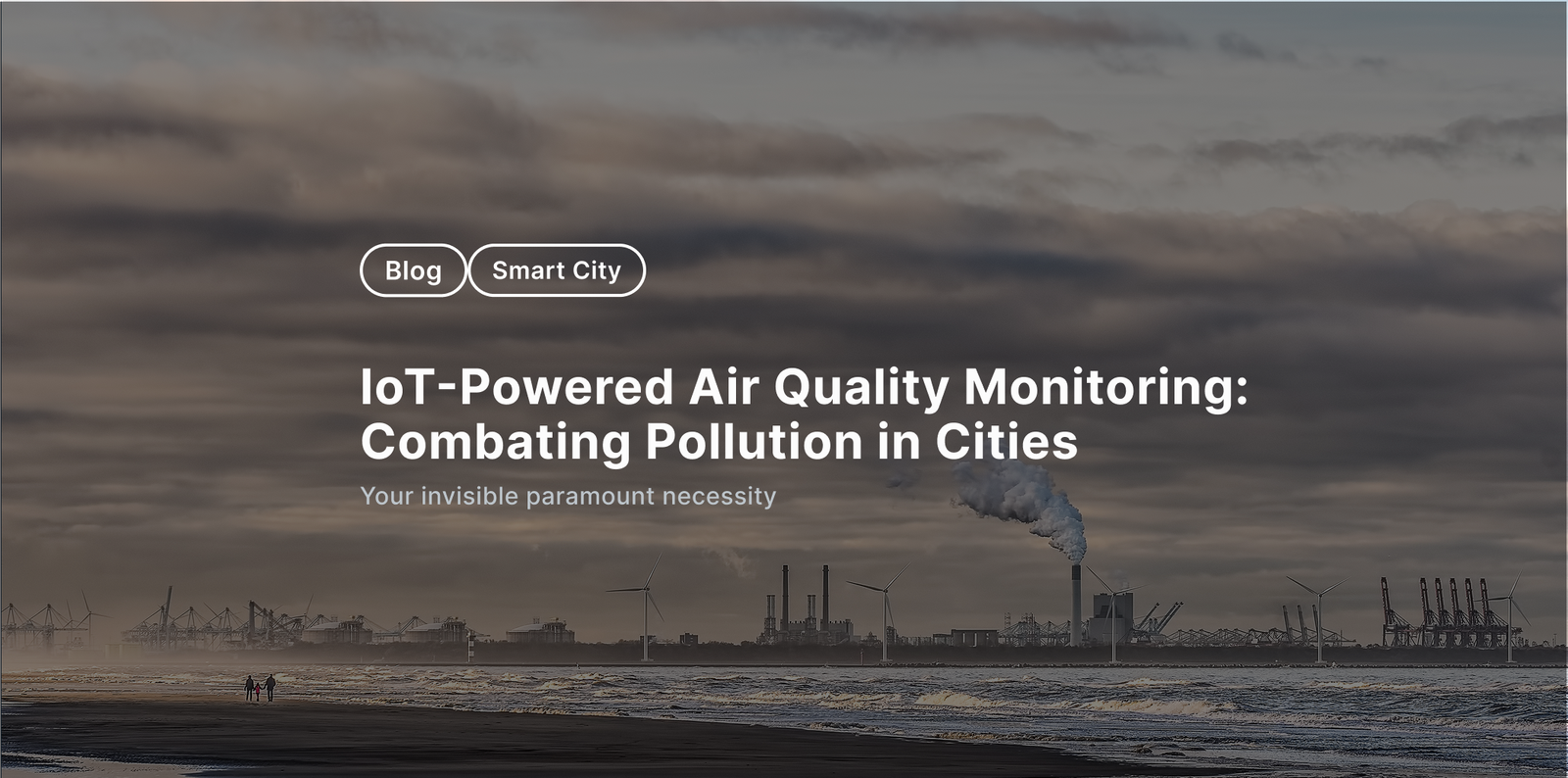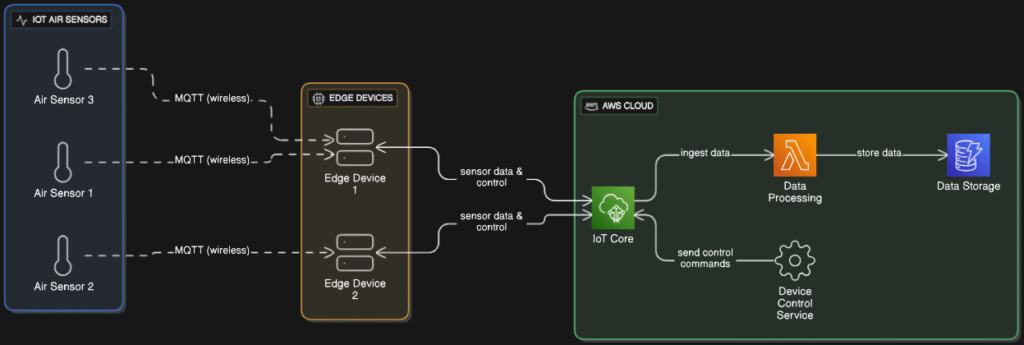✆ + 1-646-235-9076 ⏱ Mon - Fri: 24h/day
IoT-Powered Air Quality Monitoring: Combating Pollution in Cities


Air is the most essential resource we consume constantly – unlike water or food, we can’t opt out of breathing. The quality of the air we inhale affects every part of our body: lungs, heart, brain, and even long-term cognitive and physical development in children. When polluted, air becomes a silent threat.
Air quality refers to how clean or polluted the air is. Key indicators include the concentration of particulate matter (PM2.5, PM10), nitrogen dioxide (NO₂), sulfur dioxide (SO₂), carbon monoxide (CO), and ozone (O₃). Poor air quality is linked to respiratory diseases, cardiovascular conditions, and premature death.
Why Monitoring Matters:
- Health Warnings for Vulnerable Groups
In urban areas, where traffic and industrial emissions dominate, people with asthma, allergies, or heart conditions need real-time data to make daily decisions, such as whether to keep windows shut, avoid outdoor activities, or wear masks. - Environmental Regulation Enforcement
Real-time air quality monitoring helps identify pollution sources, like factories exceeding emission limits. Continuous data enables governments to enforce clean air regulations and issue fines when thresholds are violated. - Data-Driven Urban Planning
Air quality trends help city planners and policymakers identify pollution hotspots and take action, from changing traffic patterns to introducing low-emission zones or green spaces.
Case in Point – Paris, France
In 2024, a citywide push to reduce car usage was driven by IoT-powered pollution data.


Source: Airparif
According to The Washington Post, since deploying thousands of sensors:
- Nitrogen dioxide levels fell by 40% in critical districts.
- Emergency room visits for asthma dropped by 30%
- Citizens began actively adjusting their behavior based on air quality alerts.
This is not just data — it’s life-saving information.
How IoT Enables Smarter Air Monitoring
Modern air quality monitoring requires continuous, scalable, low-cost, and distributed infrastructure. IoT technologies provide the backbone for this transformation.
IoT Components:
- Sensors: Devices that measure pollutants, humidity, temperature, and more.
- Edge Devices: Process and transmit data while minimizing cloud dependency.
- Communication Protocols: MQTT, HTTP, CoAP, LoRaWAN, NB-IoT.
- Cloud & Analytics: Platforms for data storage, visualization, alerting, and decision-making.
Cloud services like AWS IoT Core, Azure IoT Hub, and Google Cloud IoT offer robust pipelines, including rules engines, alert systems, and big data analytics.


MQTT for Air Quality Monitoring
MQTT (Message Queuing Telemetry Transport) is a lightweight, publish-subscribe network protocol that transports messages between devices.
Why MQTT Works for IoT:
- Low Bandwidth Consumption: MQTT was designed for constrained devices and low-bandwidth, high-latency networks. This makes it ideal for sending short, frequent sensor updates.
- Efficient Power Usage: Devices can sleep between publish intervals, conserving energy.
- Reliable Communication: Three Quality of Service (QoS) levels allow for guaranteed delivery depending on the application’s reliability needs.
- Topic-Based Routing: Messages are published to “topics,” allowing easy filtering and routing of information.
MQTT Architecture:
- Publisher: The air sensor that sends the data.
- Broker: The server that receives all messages from publishers and routes them to subscribers (e.g., Mosquitto, EMQX).
- Subscriber: A dashboard, analytics engine, or alerting system that processes the incoming data.
Use Case:
A city with 500 air quality sensors can use MQTT to send readings every 10 seconds to a central broker. Each sensor publishes to a topic like city/zone1/air. Cloud services can subscribe to specific zones or entire categories and trigger real-time alerts or trend analytics.
MQTT Tools and Ecosystem:
- Eclipse Mosquitto: Open-source, lightweight, suitable for local or test environments.
- EMQX: Scalable MQTT broker with clustering, security, and rule engine.
- HiveMQ: Enterprise-grade MQTT with Kafka integration.
- AWS IoT Core: Managed MQTT broker with authentication, rules engine, and analytics integrations.
LoRaWAN in City-Scale Deployments
LoRaWAN (Long Range Wide Area Network) is a Low Power Wide Area Network (LPWAN) protocol designed to wirelessly connect battery-operated devices to the internet in regional, national, or global networks.
Why LoRaWAN for Air Quality Monitoring:
- Long Communication Range: Up to 15 km in rural areas and 2–5 km in urban environments.
- Ultra-Low Power Consumption: End-nodes can operate on battery for several years.
- License-Free Spectrum: Uses unlicensed ISM bands (EU 868 MHz, US 915 MHz).
Key Components:
- LoRa End Node: A sensor device with LoRa radio (e.g., RAK7204, Dragino LPS8).
- LoRa Gateway: Collects packets from nodes and forwards them to a network server.
- Network Server: Validates data, applies logic (e.g., The Things Stack, ChirpStack).
- Application Server: Stores and visualizes sensor data (e.g., Node-RED, Grafana, AWS).
Benefits:
- Scalability: A single gateway can manage hundreds of nodes.
- Low Cost: Affordable infrastructure with community-supported networks (e.g., The Things Network).
- Adaptive Data Rate (ADR): Optimizes communication performance and battery life.
Use Case:
Deploying 100 air sensors across a mid-size city requires only 5–10 gateways. Sensors send data every 5–15 minutes to the nearest gateway, which forwards it to a central server. Integration with MQTT or HTTPS enables data visualization and real-time alerts.
Limitations:
- Not Real-Time: Best suited for data intervals >1 minute.
- Payload Size Limits: Max payload typically 51–222 bytes, depending on data rate.
- Duty Cycle Restrictions: Limited transmit frequency per device in EU/US regulatory environments.
Integrated Solutions by Fordewind.io
At Fordewind.io, we specialize in designing and deploying end-to-end IoT monitoring systems tailored for city-scale solutions, industrial zones, and smart infrastructure.
Why Choose Us?
- Proven Architecture
From edge device provisioning to secure MQTT communication, we build robust and scalable infrastructure that integrates seamlessly with AWS, Azure, or on-prem systems. - Compliance-Ready
Our systems support data retention policies, anomaly detection, and can be adapted to meet environmental regulations and smart city frameworks. - Custom Dashboards & Alerts
We offer real-time visualizations, threshold-based alerts, and integration with citizen-facing mobile apps or enterprise systems. - Experience Across Verticals
We’ve helped municipalities, green tech startups, and smart home companies deploy reliable pollution detection and environmental monitoring setups across the US and Europe.
Whether you’re an investor, public planner, or product owner, we help you bridge the gap between air and insight.
Conclusion: The Future Breathes Through Data
As cities grow and environmental concerns mount, air quality monitoring is no longer optional — it’s a necessity for public health and policy.
With IoT-powered systems, we can create cleaner, safer, and more responsive urban environments. Real-time insights empower citizens, inform authorities, and hold polluters accountable.
At Fordewind.io, we’re ready to architect the infrastructure that lets your project breathe.
Let’s build it together.